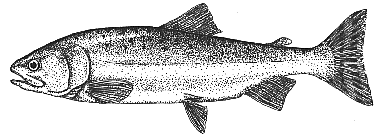
A Fisherman Looks at Pink Salmon
with
D.C. Reid
illustrations by Barb Krimmer
Smallest of the five Pacific species,
pink salmon
reach spawning weights of 5 - 11 pounds in their second summer. They are the only salmon to return to their river of origin after two years, a characteristic which may account for their diminutive size. Pink breed true, that is, they return with the same fish with which they hatched. Accordingly, cross-fertilization from one year to the next does not occur.
On the southern coast, the consequences of breeding true have been evident for 70 years. In the early 1920s, a major landslide at
Hell's Gate
, a treacherous obstacle on the Fraser River, prevented virtually all pink salmon from migrating to their short spawning streams. Since then, pink salmon have returned in catchable numbers only in odd-numbered years, swinging south around
Vancouver Island
on their approach from the open Pacific. In mid-island waters, pink return in both even- and odd-numbered years, while on the northern coast of British Columbia, pink return to short coastal streams in even-numbered years.
Females lay 1200 - 1900 eggs - the fewest number of any species. As with other salmonids, eggs reside within a relatively thick (.45 millimeter), structurally complex membrane. Millions of sperm dash frantically for the only opening in the egg, the micropyle, which closes immediately upon fertilization. In three to five minutes, unsuccessful sperm swell with water and explode.

Pink salmon spend their entire lives at sea, a characteristic shared only with chum. After emerging from the gravel bed, pink migrate immediately to the ocean, migrating north along the coast of British Columbia and the Alaska panhandle at a rate of 3 - 16 miles per day. They then swing west into the open Pacific. For this reason, they are never a resident species and are caught only as mature, migratory adults en route to spawning. It is rare indeed to catch a pink shorter than the legal size limit of 12 inches (30 cm).
What pink salmon may lack in size they make up for in sheer numbers. The most numerous of salmon, the summer run passing southern Vancouver Island, for example, averages 8- 10,000,000 fish. Alaska-bound schools sometimes surpass 35,000,000. These salmon beetle by in vast schools, stretching out to as much as15 miles offshore. Distinctive behaviour includes swimming with dorsal fins sticking from the surface. On glassy summery seas, the fisher is surrounded by what look like herds of toothpicks. Another behaviour includes fish following one another in lines, porpoising one after the other.
Easily identified by the large browny spots on their tails, pink sport aquamarine dorsal surfaces, the tiniest bright silver scales in the ocean and an over-abundance of disease-preventing slime. Accordingly, commercial fishers call them "slimies". And they are slimy indeed. The angler is cautioned to clean up the boat after each salmon or risk ending up in the water with the rest of them. Males may be further identified by their decided dowager's hump of fat, hence the nickname "humpie". Gill rakers, the comblike structures on gill bars provide another clue: each bar supports 24 - 35 rakers.
The only omnivore of the salmonid class, pink have light, yellowish mouths with few teeth. The angler is advised to take care during netting as these mouths rip easily. Pink salmon will eat virtually any salmon food, including plankton, baitfish, squid and crustaceans. Their meat is a sandy pink, the least fishy of all salmon, and often preferred smoked, a true west coast delicacy, one that should be savoured the moment the treat emerges from the smokehouse.
During their migratory run from mid July to mid September, pink provide the most spectacular, pandemonium fishing of any species. Much to the fisher's delight, pink are indescriminate feeders, biting at the crack of dawn, an hour later, on tide changes and off tide changes, an hour before lunch and after lunch, at dusk and after dusk, and any old other time that takes their fancy. It is common to receive fish on two or three rods simultaneously. Understandably, this fishery is keenly anticipated and well worth the two year wait.
Angling strategy arises from a consideration of pink behaviour. These salmon swim in vast schools of rivulets of fish. Easily moved by ocean currents, pink are commonly found in tidelines - areas where tidal flow concentrates plankton and baitfish. Successful anglers relentlessly search for tidelines, identified as dark lines on the glassy summer waters.
Once a bite is received, the boat turns and goes back through the same spot. If the current prevents this, fishing lines are retrieved, the boat motors smartly to the other side and once again fishes directly through the school. Given the spread-out nature of schools and the amount of fishable ocean, the angler keeps moving until contact is made. Once contact is established, the fisher circles the area, typically fishing shallower than 50 feet deep.
The lure of choice may change daily, and recommendations should be sought at the local marina on the day of pursuit; however, the most common lure would have to be the pink hootchie. Other lures to consider include pink plugs, Apexes, Krippled Ks, and a variety of squirts and hootchies. Successful patterns include the blue baron, irish mist, mint tulip, fiesta, day-glo orange, pink and white stripe and bubble gum. Being true omnivores, pink occasionally prefer bait, usually anchovy. Leaders of 30 - 40 inches and a minimum of 25 pound test accurately convey snap from flashers.
Pink fishing is truly a fishery to be experienced. It can be an endless screech of adrenaline as everyone catches their limit and finally has to admit their arms hurt to much to continue. When the pink come in, grab your A535 and head for nirvana.
More information on Pink Salmon & other
Game Fish
of B.C.
|




